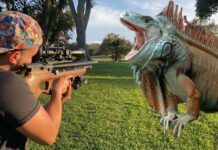Table of Contents
What Eats A Deer? – 10 Deer Predators
In this article, we talk about the mighty predators of deer
For a long time, deer have been a commonly hunted animal – both by humans and other animals.
In fact, they were introduced into many places, such as New Zealand, simply for the purpose of pleasure hunting.
6 species of deer are found in the United States, though only two of them are native to the land.
While thinking of deer, you might be thinking of only smaller, white-tailed species (such as Bambi). However, larger animals such as moose and reindeer are also species of deer.
Despite their larger size, even these species of deer are herbivores. All deer have many large and small predators in the wild, some of whom we discuss below.
Deer Facts
- Deer have eyes placed on the opposite sides of their heads. This allows deer to have a 310 degrees visual field. Compare this to the vision field of humans, which is only 100 degrees!
- New-born fawns have underdeveloped scent glands and are essentially odorless. After birth, the doe licks away any odor-causing component that can be detected by predators.
- Antlers are commonly used to distinguish male deer (have antlers) from females (do not have antlers). However, both sexes of the Chinese water deer do not possess antlers. The males are instead identified by their long canines or tusks.
- Now extinct, the Irish elk deer was the largest-ever deer species. They could grow up to seven feet in size. Their antlers spanned as much as 12 feet!
What Animals Eat Deer?
Being lower in the food chain, deer are a primary food source for many carnivorous animals in the jungle.
They are mostly defenseless in front of larger predators and only have their speed to help them escape. Older or baby deer and disabled members of the herd are at high risk of being hunted.
Wolves Eat Deer
Deer have many natural predators. Wolves are one of the apex predators in the jungle, and deer form an important part of their diet.
Wolves hunt in packs. A single deer kill can feed a wolf pack multiple times.
Since deer also move in herds, wolves tend to narrow in on them until one of the deer gets separated or left behind.
Deer have no way of protecting themselves other than by running away or fighting with their antlers.
Coyotes Prey on Deer
Coyotes are also natural predators of deer. Unlike wolves, they are solitary creatures but will still hunt in packs to bring down larger animals.
Coyotes mainly eat many small animals, including rodents and birds. However, they are scavengers and often feed on left-behind deer carcasses instead of actively hunting them.
There has been much debate as to whether coyotes are negatively impacting the deer population in some areas.
However, it’s hard to tell whether they actively kill or simply eat leftover venison.
Bear Feed on Deer
Bears feed on a variety of animals and plants. They are omnivorous, and their diet consists of fish, small mammals, berries, grains, and honey.
They also hunt deer on occasion, as well as feed on deer carcasses.
Beers are opportunistic (lazy) hunters. They prefer to target babies and sick deer for their hunt because they are no match for the deer’s speed.
Not only are they slower, they can only cover short distances even if they try to run fast.
Hogs Are Predators of Deer
Wild hogs are generally considered an invasive species. They are aggressive and exist in the same regions as deer.
Hence both species cross paths, often making a meal out of the deer. Hogs are not native to Central and North America. They were brought there by Spanish explorers as a food source.
Now, hogs have become a primary predator responsible for the decline of the white-tailed deer population.
They actively hunt deer as well as feed on deer carcasses. New-born fawns are common victims, as they are left behind by their mothers in leaf beds to forage.
Mountain Lions Are Deer Hunters
Both whitetail and mule deer form an important part of a mountain lion’s diet. Mountain lions are a type of big cat that is responsible for hunting at least one deer per week.
Apart from deer, they also feed on elk, moose, sheep, rabbits, raccoons, and other smaller mammals. They may also eat cubs of other apex predators, such as coyotes and wolves.
Despite this, deer are their favorite as one deer can sustain them for a long time.
They hunt by aiming at the neck of these animals and snapping their spine. Mountain lions are solitary hunters.
Lynxes Can Eat Deer
Lynxes feed mainly on two types of deer – the roe deer and the red deer. This is because their habitat range primarily overlaps with the range of these two deer species.
Lynxes are big cats that are mainly carnivorous. Along with deer, they prey on smaller rodents and mammals like rabbits, raccoons, marmots, squirrels, and more.
Sometimes, they may feed on older deer carcasses. Usually, they do not hunt larger animals and prefer to eat carcasses in such cases.
Wolverines Are Deer Predators
Despite the name, wolverines are actually a type of bear. Wolverines are small in size but are bold and aggressive to take on any animal crossing their path.
Deer are not one of the primary diet meats they rely on. They mostly eat smaller mammals.
However, fawns and disabled deer can be good game for wolverines. They are not as agile and cannot hunt faster and stronger deer.
They scavenge and often eat old deer, elk, and moose carcasses.
Alligators Consume Deer
Alligators are one of the top predators of deer. They float just beneath the water, and camouflage themselves against dried wood logs.
They grab deer from the water’s edge as the herd comes looking for a sip.
They have extremely strong jaws with great crushing power. They snap the necks of their prey and drag them underwater until the animal passes out.
Alligators are cold-blooded and run on low energy. They only need one major feeding a week to keep going.
Large Birds of Prey Can Eat Deer
Deer fawns, when born, are extremely defenseless. Both young deer and sick deer can be good game for large birds of prey such as hawks and eagles.
Wild crows and vultures feed on old deer carcasses left behind by other predators.
Raptors can often take away smaller-sized deer in flight. However, this is rare, and prey birds mostly prefer smaller animals, such as rabbits and squirrels.
Humans Hunt Deer For Meat
Deer have been a prime sport animal for humans for ages. For ages, deer have been hunted as a sport as well as for food.
Deer meat, known as venison, is bitter but nutritious and high in animal protein.
Deer hunting is now illegal in most parts of the world. In the US, it is a regulated activity within certain areas, where hunting is allowed during deer hunting season if they pose a threat to crops.
This is not considered poaching as long as you have a deer hunting license issued by the State.
What Does A Deer Eat?
Deer are herbivorous animals and survive on a green, leafy diet of plants.
A typical deer diet consists of grass, acorns, sedges, leaves from trees, ground vegetation, buts, berries, alfalfa, fruits, mushrooms, and more.
Because of their dietary preferences, they sometimes also destroy crops. Carrots (or any broad-leaf vegetable), for example is a target crop which often gets destroyed if deer are around.
To remain healthy, a deer must consume around 6 to 8 percent of its overall body weight in vegetation daily.
Generally, male deer weigh between 120 to 160 pounds. Females weigh less, going up to 120 pounds.
Other Deer Articles
- Deer hunting season in the US ranges from October to December. If you are a deer hunter, here are some tips to avoid blunders.
- Deer have a very sharp sense of smell and hearing. Those hunting deer might wonder if keeping a propane heater with them in the cold might ward off deer. Deer can smell propane heaters; you can find out more in our other article.
- If you’re using acorns as bait and the deer are not taking it – it could be because it’s too hard. We have covered more on this here.
- If you have cows and other cattle nearby, this could be alarming the deer as well – check it out here.
- If you’re worried that they’re being spooked by the smell of human poop or urine – you can read more here.
- Foggy weather can also restrict their movement. Find a cold, low-humidity day for hunting – read more in our article on deer movement in the fog here.
Frequently Asked Questions
Wrap Up
Deer are common wild animals found in almost every forest and savanna across the world.
Other than Australia and Antarctica, they thrive on every continent and are an important link in the food chain.
Deer herds are necessary for vegetation control and for the survival of larger predators. Many wild cats, such as lions, coyotes and other big predators love to hunt deer.
While they are able to use their speed to protect themselves, the young and the sick are typically easy prey for these large animal.
Currently, deer have a conservation status of “Least Concern.” After bans on hunting deer in many countries for meat and sport, their population has been growing constantly.
Perhaps, more than anything else, human being are the biggest threat to deer.
Thank you for reading.











































![Air gun 101: The differences between .177 & .22 – Which jobs they do best ? [Infographic]](https://airgunmaniac.com/wp-content/uploads/2024/11/1773-150x150.jpeg)